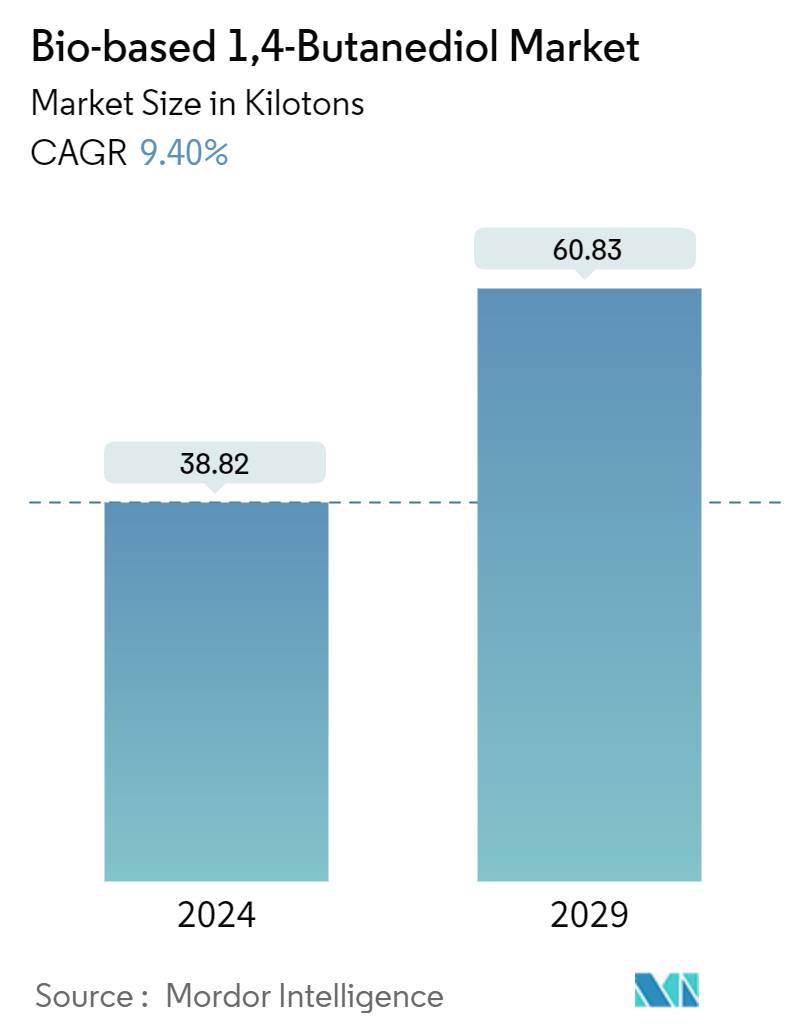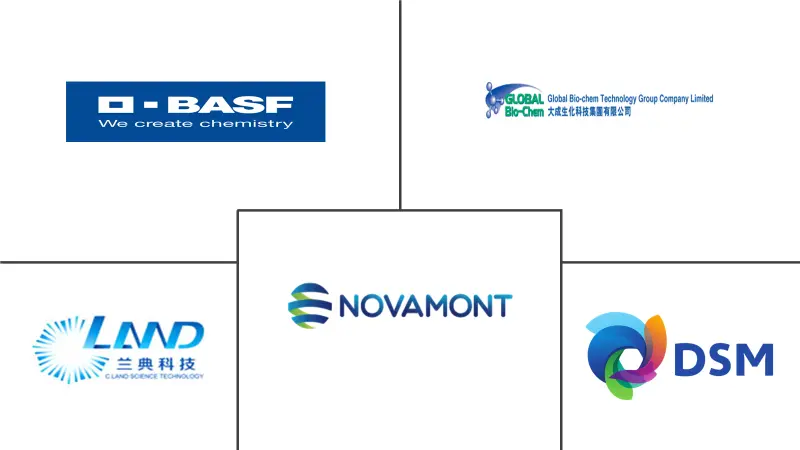Market Size of Bio-based 1,4-Butanediol Industry

| Study Period | 2019 - 2029 |
| Base Year For Estimation | 2023 |
| CAGR (2024 - 2029) | 9.45 % |
| Fastest Growing Market | North America |
| Largest Market | Europe |
| Market Concentration | High |
Major Players
*Disclaimer: Major Players sorted in no particular order |
Bio-based 1,4-Butanediol Market Analysis
The Bio-based 1,4-Butanediol Market size is estimated at 38.82 kilotons in 2024, and is expected to reach 60.83 kilotons by 2029, growing at a CAGR of 9.40% during the forecast period (2024-2029).
In 2020, the COVID-19 pandemic affected the bio-based 1,4-butanediol market due to quarantined workforces, general businesses being shut down, and disrupted supply chains. Many factories responsible for bio-based 1,4-butanediol production were also shut down during the pandemic. However, in 2021, the market gradually started to recover as governments worldwide started to counter the problems caused by the pandemic.
- The major factors driving the market's growth are the increasing demand for polybutylene terephthalate (PBT) from various industries and stringent government regulations.
- On the flip side, massive competition from fossil fuel-based products remains a concern for the market studied.
- The shifting focus toward eco-friendly products will likely provide opportunities for the market during the forecast period.
- Europe dominated the market across the world. The demand in the region is driven by the growing usage of bio-based 1,4-butanediol in industries such as automotive, electronics, and consumer appliances.
Bio-based 1,4-Butanediol Industry Segmentation
Bio-based 1,4-butanediol, majorly manufactured using sugar fermentation, is polymerized with terephthalic acid to produce polybutylene terephthalate (PBT). PBT is a semi-crystalline, white, or off-white thermoplastic polyester with higher impact strength, better electrical resistance, and exceptional chemical resistance. Such PBT properties make it widely suitable for applications in the electrical and electronics, telecommunications and IT, and automotive industries.
The bio-based 1,4 butanediol market is segmented by application, end-user industry, and geography. By application, the market is segmented into tetrahydrofuran (THF), polybutylene terephthalate (PBT), gamma-butyrolactone (GBL), polyurethane (PU), and other applications (polybutylene succinate (PBS), etc.). By end-user industry, the market is segmented into automotive, electrical and electronics, textile, and other end-user industries. The report also covers the market size and forecasts for the bio-based 1,4 butanediol market in 27 countries across major regions. For each segment, the market sizing and forecasts were done based on volume (kilotons).
| Application | |
| Tetrahydrofuran (THF) | |
| Polybutylene Terephthalate (PBT) | |
| Gamma-Butyrolactone (GBL) | |
| Polyurethane (PU) | |
| Other Applications |
| End-user Industry | |
| Automotive | |
| Electrical and Electronics | |
| Textile | |
| Other End-user Industries |
| Geography | |||||||||||
| |||||||||||
| |||||||||||
| |||||||||||
|
Bio-based 1,4-Butanediol Market Size Summary
The bio-based 1,4-butanediol market is poised for significant growth, driven by increasing demand from industries such as automotive, electronics, and textiles. The market's expansion is supported by the rising need for polybutylene terephthalate (PBT) and stringent government regulations favoring eco-friendly alternatives. Despite challenges from fossil fuel-based products, the shift towards sustainable solutions presents substantial opportunities. Europe leads the global market, with Germany and the United Kingdom playing pivotal roles due to their robust automotive and electronics sectors. The region's demand is further bolstered by the growing consumer appliances market, which benefits from rising disposable incomes and increased consumer spending.
The market landscape is characterized by an oligopoly, with Novamont SpA holding a dominant position alongside other key players like Shandong LanDian Biological Technology, DSM, BASF SE, and Global Bio-chem Technology Group Company Limited. Recent developments include BASF SE's strategic acquisition of bio-based 1,4-butanediol from Qore LLC to enhance its product offerings, and the successful operation of a two-step bio-BDO facility in China by Shandong LanDian Biological Technology. These advancements underscore the industry's commitment to expanding bio-based product lines and meeting the growing demand for sustainable materials in various applications, including spandex manufacturing for the textile industry.
Bio-based 1,4-Butanediol Market Size - Table of Contents
-
1. MARKET DYNAMICS
-
1.1 Drivers
-
1.1.1 Increasing Demand for Polybutylene Terephthalate (PBT)
-
1.1.2 Stringent Government Regulations
-
-
1.2 Restraints
-
1.2.1 High Competition from Fossil Fuel-based Products
-
1.2.2 Other Restraints
-
-
1.3 Industry Value Chain Analysis
-
1.4 Porter's Five Forces Analysis
-
1.4.1 Bargaining Power of Suppliers
-
1.4.2 Bargaining Power of Buyers
-
1.4.3 Threat of New Entrants
-
1.4.4 Threat of Substitute Products and Services
-
1.4.5 Degree of Competition
-
-
1.5 Patent Analysis
-
-
2. MARKET SEGMENTATION (Market Size in Volume)
-
2.1 Application
-
2.1.1 Tetrahydrofuran (THF)
-
2.1.2 Polybutylene Terephthalate (PBT)
-
2.1.3 Gamma-Butyrolactone (GBL)
-
2.1.4 Polyurethane (PU)
-
2.1.5 Other Applications
-
-
2.2 End-user Industry
-
2.2.1 Automotive
-
2.2.2 Electrical and Electronics
-
2.2.3 Textile
-
2.2.4 Other End-user Industries
-
-
2.3 Geography
-
2.3.1 Asia-Pacific
-
2.3.1.1 China
-
2.3.1.2 India
-
2.3.1.3 Japan
-
2.3.1.4 South Korea
-
2.3.1.5 Malaysia
-
2.3.1.6 Indonesia
-
2.3.1.7 Vietnam
-
2.3.1.8 Thailand
-
2.3.1.9 Rest of Asia-Pacific
-
-
2.3.2 North America
-
2.3.2.1 United States
-
2.3.2.2 Canada
-
2.3.2.3 Mexico
-
-
2.3.3 Europe
-
2.3.3.1 Germany
-
2.3.3.2 United Kingdom
-
2.3.3.3 France
-
2.3.3.4 Italy
-
2.3.3.5 Russia
-
2.3.3.6 NORDIC
-
2.3.3.7 Spain
-
2.3.3.8 Turkey
-
2.3.3.9 Rest of Europe
-
-
2.3.4 Rest of the World
-
2.3.4.1 South America
-
2.3.4.2 Middle East and Africa
-
-
-
Bio-based 1,4-Butanediol Market Size FAQs
How big is the Bio-based 1,4-Butanediol Market?
The Bio-based 1,4-Butanediol Market size is expected to reach 38.75 kilotons in 2024 and grow at a CAGR of 9.45% to reach 60.86 kilotons by 2029.
What is the current Bio-based 1,4-Butanediol Market size?
In 2024, the Bio-based 1,4-Butanediol Market size is expected to reach 38.75 kilotons.

